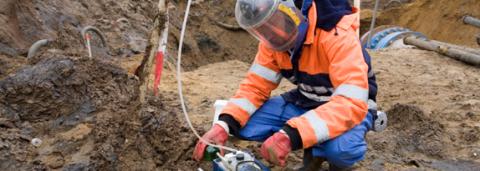
Asbestos-contaminated soil presents complex problems that can be expensive to solve. That’s why, when you find asbestos in soil, it’s especially important to get expert help.
At one time, asbestos in soil was always treated as friable in New South Wales. But in 2008, WorkCover NSW (now SafeWork NSW) released a new set of guidelines on working with asbestos. Although some things have changed with more recent legislation, the guidelines about asbestos-contaminated soil remain the same. The guidelines state:
A competent occupational hygienist should assess the site to determine:
- if the asbestos material is bonded or friable
- the extent of asbestos contamination
- safe work procedures for the remediation of the site
The assessment and safe work procedures should reflect the level of the hazards and the proposed use of the land. Environmental and planning legislative requirements must be complied with.
In other words, you need an expert to assess the situation and determine the best way to handle the asbestos.
This open-ended advice reflects our experience of dealing with asbestos in soil: we simply have to assess each case on its merits. In some cases, depending on the extent of the planned works, the whole site may have to be excavated. In other cases, a geofabric separator might provide sufficient protection.
Asbestos in soil: A complex problem
What makes asbestos in soil so complex to deal with? There are a number of factors at work.
The first factor is self-evident: soil is more difficult to “inspect” than above-ground materials. It has to be dug up. For this reason, we’ll usually add a disclaimer to asbestos clearance certificates, to the effect that asbestos may still be present in soil beneath the site: we simply can’t get to this soil to test it unless there’s a particular reason to do so.
The second factor is the range of different types of asbestos that can be found in soil. It may be an inherently friable form of asbestos like pipe lagging. It may be a bonded form of asbestos like fibro, which can become friable under certain conditions. It may be asbestos waste that has formerly been illegally dumped at the site, or just left behind and buried at a time when the need for safe disposal wasn’t so well known. It may be a combination of all these. Each kind of asbestos requires a different response.
The third factor that makes asbestos in soil a complex issue is the sheer cost of removing it. The extent of contamination can be difficult to pin down, and excavating soil from a large site is a massive operation. Disposal facilities are also an issue: if soil was excavated from every asbestos-containing site in Australia, there wouldn’t be enough space in current facilities to safely to dispose of the soil.
For all these reasons, if you have an issue with asbestos contaminated soil, you need to talk to an expert. Airsafe has over 20 years of experience dealing with asbestos in soil, so if you’re in NSW, give us a call on (02) 9555 9034. We’ll get one of our consultants on site quickly – often the same day. Once there, we’ll help you devise a plan that keeps your staff and contractors safe with as little disruption to your business as possible.
If you’ve found something in soil that you suspect might be asbestos, Airsafe can also test soil samples for asbestos.



